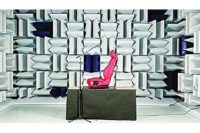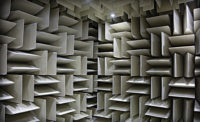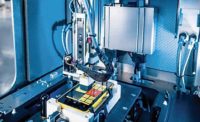In the small town of Wauwatosa, WI, sits the state-of-the-art noise, vibration and harshness laboratory operated by Briggs & Stratton. Within the lab are two anechoic chambers outfitted with sound-absorbing acoustic wedges.
Briggs & Stratton engineers use these chambers to analyze and tailor the noise produced by the company’s small engines, which are used in lawn, garden and light construction equipment. Such equipment ranges from lawn mowers and standby generators, to power washers, snow blowers and air compressors.
The lab opened in May 2017 after its chambers were carefully designed and built by engineers at Eckel Noise Control Technologies and ACS Inc. Eckel supplied the wedges for the project, but wedge installation was performed by Viking Enterprises Inc. of Waterford, CT. ACS renovated the chambers in late 2018.
The smaller chamber, known as the 2M because it accommodates a 2-meter hemispherical array of microphones for sound testing, has an interior dimension of 21 feet, 1.5 inches wide; 26 feet, 4.5 inches long; and 10 feet, 9 inches high. This chamber is used for engine product development and testing of smaller finished products like lawn mowers, snow blowers and pressure washers. An overhead monorail crane moves equipment into place for testing.
The larger chamber, called the 4M, has a 4-meter hemispherical microphone array and has an interior dimension of 32 feet, 8.75 inches wide; 33 feet, 0.75 inch long; and 17 feet, 8 inches high. Similar to the 2M chamber, the 4M chamber features a large overhead bridge crane to move equipment.
This chamber allows engineers to analyze larger equipment like lawn and garden tractors and large home standby generators. It is also used for certification testing to ensure that products comply with domestic and international noise regulations.
Eckel outfitted both chambers with its standard,
perforated-metal sound absorbing wedges. These wedges are designed with a 100-hertz cutoff point (per ISO 3745 standard), meaning that 99 percent of the sound energy generated above that frequency is absorbed by the panels.
Jeff Morse, vice president of engineering at Eckel, says a key design challenge is maintaining the acoustic integrity of the chamber while meeting stringent HVAC system requirements. Both chambers are designed with ventilation systems that provide 100 percent air change per minute to accommodate engine exhaust while maintaining a constant chamber temperature.
Equally important, both chambers feature a data-gathering dynamometer isolated in a sealed area below the floor. A 30-hp dynamometer is contained in the 2M chamber. Within the floor of the 4M is a 40-hp dynamometer.
Because the dynamometers are isolated, their noise does not interfere with that of any running engine, ensuring consistent and reliable measurements. Brett Birschbach, NVH engineering manager at Briggs & Stratton, says that dynamometer sound testing helps company engineers design engines with a more pleasing tone and pitch. This lessens noise concerns when working in residential areas.
Briggs & Stratton engineers especially like that the lab has two chambers, thereby allowing for high productivity testing. This is important, because the company makes engines for its own branded products, as well as other OEMs such as MTD Products and John Deere. Briggs & Stratton also offers the use of the chambers to those OEMs for the testing of their finished products.
Since becoming operational, the chambers have been in use almost non-stop. The only noise coming from them, according to Morse, is the hum of activity from equipment moving in and out.
For more information on sound-absorbing acoustic wedges, call 617-491-3221 or visit www.eckelusa.com.







